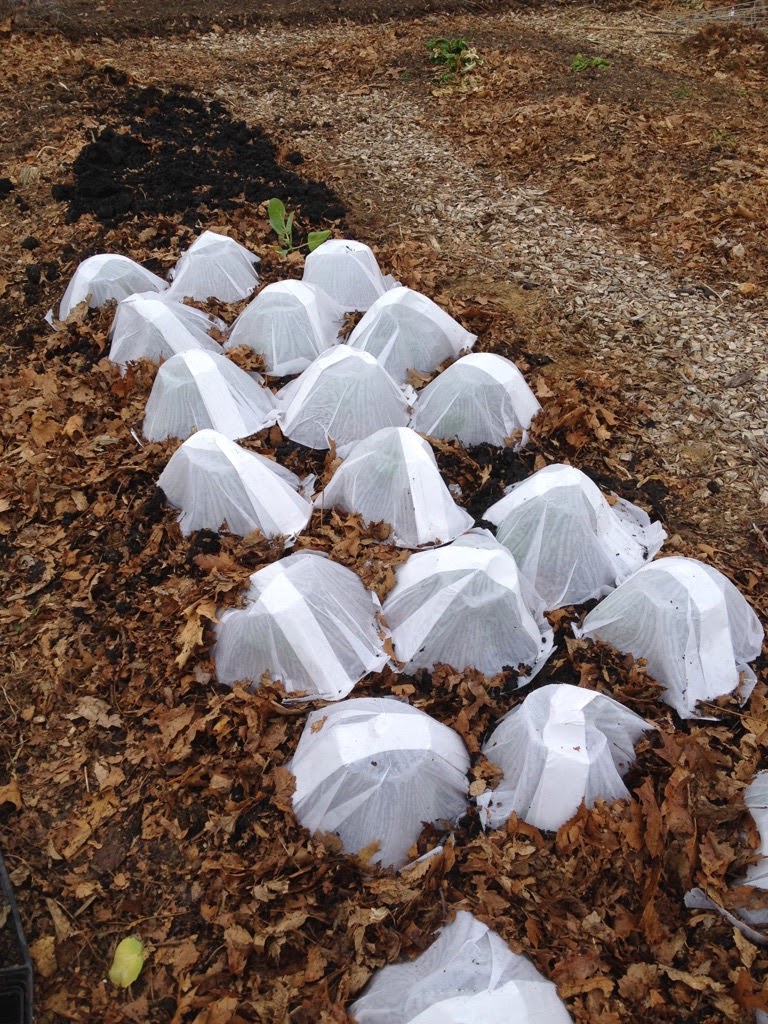Keeping the plants covered
If there's one thing you learn after living in Maryland for a while, it's that spring is variable. (Not just in Maryland, of course, but that's where I am.) Just when we've had some brilliant sunny days in the 70s and even 80s, the cold hits again and makes you think you're back in winter. This week we've had nights dipping into the 30s, and some plants that were happy a week ago are not so sure they want to be outside.
And then of course there are the plants you want to put into the ground (or outside in pots to harden off) nice and early for a head start, before you can be sure temperatures are going to stay above freezing, and the ones that need protection against the insects that are already flying around - and you really have to think covers and protective devices. There are lots of these on the market, and we've posted about quite a few. Here are some I've used just this spring.
The good old basic floating row cover is what I reach for first. This one is a summer-weight insect barrier, protecting cabbages from the butterflies that want to lay eggs on them, but even this lightweight cover helps to keep plants a little bit warmer, and stops some of the drying effect of those fierce winds we've been having. (Just make sure it's held down well.)
We also use other materials to keep insects off, including this wedding netting that works perfectly over a wire frame in containers.
I was curious this winter about a product called HotKaps, so I ordered some and used them over my seedling cabbages when I first planted them in my community garden (this photo is from March). The plants now have row cover over them, but I had neglected to order more of that, oops, so had to go with these mini-covers made of wax paper. My conclusion is that I don't like them, but they may do well for you if you have nice even friable soil that you can pile around the edges of each cap to hold it down, though I'd advise using soil staples as well. I was putting them down on a windy, rainy day, and had lumpy soil and compost plus leaves to work with, and only enough staples to use one per cap. They were finicky and annoying, and they keep the rain out so need to be lifted so the plants can be watered. Supposedly they are reusable, but I threw these out after removing them.
I may have mentioned in a previous post that I ended up with huge Sweet Mojo tomato seedlings because I mistook the seeds for those of peppers and put them in too early. (My other tomato seedlings are still inside, and a well-behaved four to six inches high now.) Well, I got tired of trying to accommodate these three huge plants, and took them out to harden off and then be planted out, two in the demo garden and one in my home garden, just before our drop in nighttime temperatures. We are experimenting with two protection methods for these way-before-Mother's-Day tomatoes. This red one is a Kozy Coat - similar to the Wall-o-Water device. You fill the plastic channels around the outside with water, which both holds the tube down and creates a little greenhouse to keep the plant warm. I checked this one today and it is doing fine, as is the one in my slightly-less-windy home garden.
For the other plant, we made a mini-tunnel out of a perforated plastic material that lets air in but keeps the plant warm. It won't protect against a hard frost, but it also shouldn't fry the plant unless temperatures go way up. Here's a close-up:
We should be able to remove these devices in a week or two, depending on the forecast - and I'll keep some of the plastic around to pop back on if we have another of those mid-May frosts. Tomato plants planted outside this early, even with protection, don't tend to grow much, so I don't consider this an ideal situation or even an advantage, just a necessary improvisation - I simply had no place to put those plants! If my cold frames were taller, I'd stick them in there.
Speaking of cold frames - here are mine pictured last month when the cabbages were still hardening off -
- I love them, but I was reminded of the disadvantage of lightweight aluminum and plastic yesterday when I went outside to close them for the night (they've got some flower, lettuce, and mung bean seedlings in them now) and stopped, dumbfounded, swearing that I had possessed two cold frames last I looked, wondering if there was a cold frame thief operating in my neighborhood... until I realized that one of them had blown completely away and was lodged a few feet downhill by my garden fence, luckily undamaged. It's now weighted down by a plank of wood.
What are your favorite ways of protecting plants when they need a little extra help?







0 Response to "Keeping the plants covered"
Post a Comment